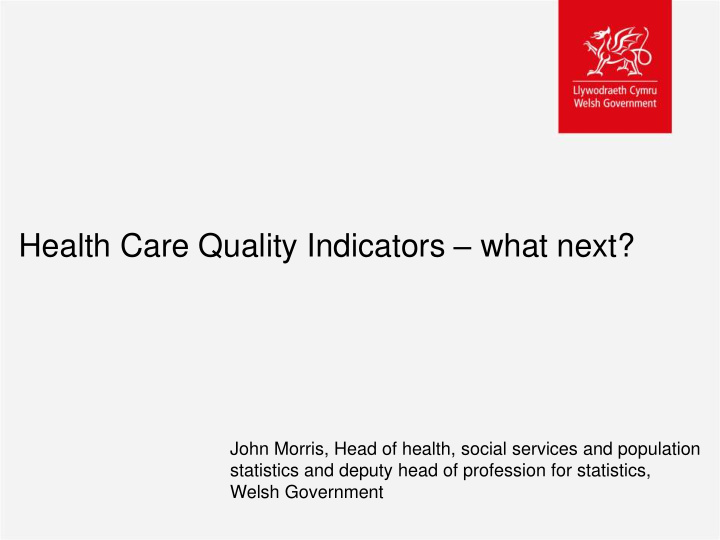



Health Care Quality Indicators – what next? John Morris, Head of health, social services and population statistics and deputy head of profession for statistics, Welsh Government
Outline • Four Nations Group • Background to the Health Care Quality Indicators (HCQIs) • Development • Results from first publication • What next? • Short update on Health stats in Wales
Four Nations group Used to have the health and social care theme group - groups ceased to exist following review Statisticians from the four nations continued to meet afterwards to discuss common areas of interest. Representation from DH, SG, WG, NI and ONS typically. Not met for a little while – but group needs to exist to ensure HCQIs etc are signed off.
Background to the HCQIs – what are they? The aim of the HCQIs is to measure and compare the quality of health service provision in different countries. These are produced/set by the OECD. An Expert Group has developed a set of quality indicators at the health systems level, to assess the impact of particular factors on the quality of health services. DH is the UK representative, with input from the devolved nations. The UK has been providing data to the OECD for the HCQIs for a number of years. Data are provided by the devolved nations to NHS Digital who compile UK figures which are then submitted to the OECD. http://www.oecd.org/els/health-systems/health-care-quality- indicators.htm
Background to the HCQIs – why publish? In February 2016 the OECD published a report summarising its reviews of health care quality for each of the four nations of the UK. The report included several recommendations, one of which was ‘publishing more quality and outcomes data disaggregated by country and, in particular, reporting each of the OECD’s health care quality indicators separately, for England, Scotland, Wales and Northern Ireland’. In response to this recommendation statisticians from the four nations have done some initial work to produce an experimental statistics product.
Development (1) As noted earlier, the indicators are set by the OECD Expert Group. Cover 6 broad areas: • Primary Care • Acute Care • Mental Health Care • Cancer Care • Patient Safety • Patient Experiences There are a range of indicators under each area. Note that the UK does not submit data for some indicators (where data are not available, for example, some of the prescribing indicators). The data used are based on the Health Care Quality Indicators (HCQI) submitted by the UK to the OECD as part of the 2015 Health at a Glance data collection. This was published by the OECD in 2016.
Development (2) This first set includes those which we have at least three nations data and where statisticians agree that the interpretation of the indicator appears to be consistent for those nations. The OECD HCQIs have around 50 indicators – this first set covers around a quarter of those. Life expectancy and healthy life expectancy have been included to provide some overall context to the data. The headline data have been ‘standardised’ to take account of the different age structures of the four nations (using the European Standardised Population (ESP)). This does not allow comparison to the other OECD countries, but that data were made available too.
Results These experimental statistics do not provide a full and comprehensive assessment of the quality of individual healthcare systems across the UK, and should not be used to draw such conclusions. The primary purpose for the product was to invite user feedback, and in particular to receive comments on how the product might be developed further. Much debate is often focused on comparison between the four nations in terms of waiting times, these indicators can be used alongside those to give a more rounded picture of quality of care in the NHS. http://www.isdscotland.org/health-topics/Public- Health/publications/2017-02-21/visualisation.asp
What next? (1) Statisticians in the four nations have agreed that this is the start of a programme of work using these indicators and that future iterations will be based on the 2017 OECD HCQI submission and could include additional indicators and more contextual information. Comparable outcome indicators exist such as life expectancy, cancer survival and mortality. But there are few other contextual measures that are comparable between the four nations, eg obesity. Are users aware of the European Health Interview Survey (EHIS)?
What next? (2) Future work depends partly on feedback from users on the usefulness of this first iteration. However it is not clear what the demand and feedback is from users on the product. Resources within the four nations for this work rely on clear demand from users to justify the time to produce (and indeed develop) them.
Update on health stats in Wales 1. Health stats landscape – working on a ‘Welsh‘ version. Will be interactive and include ONS (and any other relevant official stats for Wales) 2. Increased number of named official stats producers in November 2017 via the Official Statistics (Wales) Order 2017. Includes: WAST, EASC, Velindre (to include NHS Wales SSP+NWIS), Social Care Wales) – PHW 3. More coherent reporting of NHS Activity and Performance statistics by WG since May 2017 – including PowerBI dashboard 4. StatsWales 4* open data and fully bilingual (for live cubes) 5. Well-being of Wales report and Future Trends Wales
Recommend
More recommend